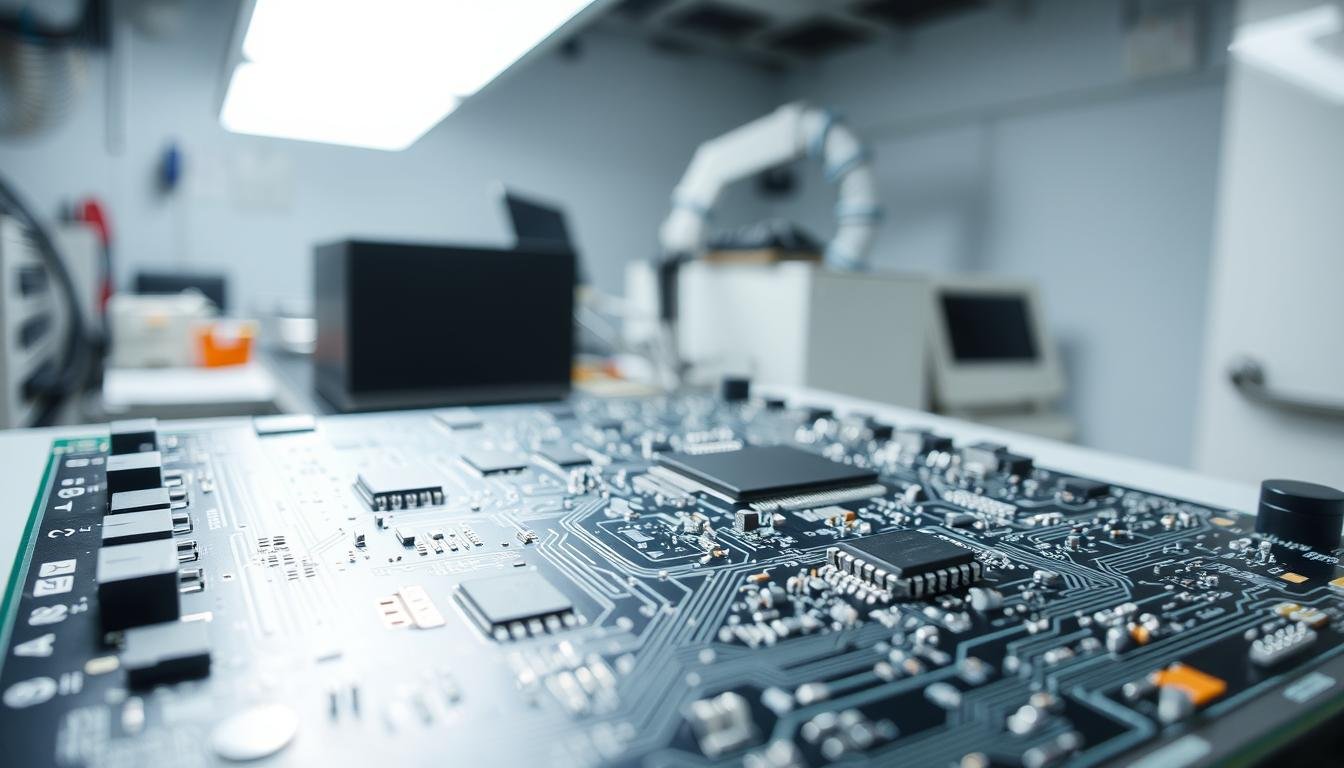Imagine a scenario where a heartbeat-monitoring system fails during surgery. Could the root cause trace back to a single compromised circuit board? This isn’t hypothetical—precision in electronics manufacturing directly impacts patient outcomes. We design specialized assemblies that power everything from implantable neurostimulators to diagnostic imaging tools, where errors aren’t options.
Unlike consumer gadgets, these technologies demand zero-tolerance engineering. A pacemaker’s circuitry operates flawlessly for decades. Blood pressure monitors require absolute accuracy. Such reliability stems from rigorous standards that govern every layer of production—materials, testing, and traceability.
Regulatory frameworks like FDA 21 CFR Part 820 and ISO 13485 shape how we approach manufacturing. These aren’t bureaucratic hurdles but guardrails ensuring patient safety. Our processes align with IPC-A-610 and IEC 60601 benchmarks, which address everything from solder quality to electromagnetic compatibility.
Key Takeaways
- Medical-grade electronics require 10x higher reliability than consumer products
- FDA and ISO standards enforce traceability across the entire supply chain
- Comprehensive quality management systems (QMS) are non-negotiable
- Failure rates below 0.1% are industry expectations for critical care devices
- Design considerations include sterilization compatibility and long-term biocompatibility
Understanding the Basics of Medical PCBA
Every diagnostic scanner and infusion pump relies on engineered precision at the component level. Unlike consumer electronics, healthcare technologies demand error-free performance across decades of use. This starts with understanding how specialized circuit systems function.
Core Elements of Medical-Grade Assemblies
Medical-grade circuit systems combine standard and specialized parts. Resistors regulate current flow. Capacitors store energy. Integrated circuits process data. Connectors enable device interfaces. What sets them apart? Biocompatible coatings and sterilization-resistant materials ensure safe patient contact.
From Bare Boards to Functional Systems
A blank printed circuit board (PCB) serves as the foundation. It contains conductive pathways but no active parts. The assembly process transforms it into a functional system (PCBA) through:
- Precision placement of micro-components
- Lead-free soldering meeting ISO 13485 standards
- Rigorous electrical testing protocols
| Aspect | PCB | PCBA |
|---|---|---|
| Functionality | Non-operational base | Complete working system |
| Regulatory Focus | Material safety | Performance validation |
| Production Stage | Design verification | End-use certification |
This distinction impacts manufacturing timelines and compliance documentation. While PCBs undergo impedance testing, complete assemblies require full functional validation under simulated clinical conditions.
Regulatory Standards in Medical PCBA

When a defibrillator’s circuitry malfunctions during an emergency, regulatory failures become life-threatening realities. Three governing frameworks form the backbone of safe healthcare technology manufacturing:
Overview of IPC, ISO, and FDA Guidelines
The IPC Association connects design specifications with real-world performance through three critical benchmarks:
- IPC-A-600: Defines visual acceptance criteria for bare boards
- IPC-A-6012: Establishes performance tiers for circuit reliability
- IPC-A-610: Sets workmanship standards for completed assemblies
ISO requirements evolve alongside medical innovations. While ISO 9000 ensures baseline quality systems, ISO 13485:2016 mandates risk analysis at every production phase. This standard drives continuous improvement through documented verification processes.
Role of ISO 13485 in Ensuring Quality
FDA classifications directly influence manufacturing protocols. The Center for Devices and Radiological Health (CDRH) categorizes technologies by potential harm:
| Class | Risk Level | Examples |
|---|---|---|
| I | Low | Bandages, examination lights |
| II | Moderate | Infusion pumps, MRI scanners |
| III | High | Pacemakers, implantable defibrillators |
Class III devices demand the strictest controls – from material traceability to sterilization validation. Our medical-grade circuit manufacturing processes integrate these layered requirements, creating systems that meet both technical specifications and patient safety imperatives.
Quality Management Systems for Medical Devices

What separates life-saving technologies from ordinary electronics? A robust quality management system acts as the central nervous system of medical manufacturing. These frameworks transform abstract standards into actionable protocols, ensuring every component meets exacting safety thresholds.
Operationalizing Excellence Through QMS
Implementing ISO 13485:2016 requires more than checklists – it demands cultural alignment. Manufacturers must establish three core pillars:
- Design controls verifying component biocompatibility
- Supplier audits with real-time performance metrics
- Production monitoring using statistical process controls
“A QMS isn’t about paperwork – it’s about creating systems that catch errors before they reach patients.”
Documentation as Risk Mitigation
Traceability begins with meticulous record-keeping. Critical documents include:
| Document Type | Purpose | Retention Period |
|---|---|---|
| Device Master Record | Defines production specifications | Lifetime + 2 years |
| CAPA Reports | Tracks corrective actions | 10 years post-market |
| Batch Travelers | Records assembly milestones | Product lifecycle |
The DMAIC model drives continuous improvement. Teams analyze process deviations using real-time data, then implement controls preventing recurrence. This systematic approach reduces risk while maintaining compliance across global markets.
PCBA for Medical Devices: Quality and Compliance Requirements
In critical care scenarios, a single malfunction could mean the difference between life and death. This reality drives our approach to creating circuitry that withstands extreme operational demands while maintaining precision.
Ensuring Safety and Reliability in Design
Medical-grade electronics require layered protection systems. We implement redundant power pathways and fault-tolerant architectures that maintain functionality during component failures. Materials must endure repeated sterilization cycles without degradation.
| Design Feature | Consumer Grade | Medical Grade |
|---|---|---|
| Operating Temperature | -10°C to 60°C | -40°C to 125°C |
| Moisture Resistance | IP54 | IP68 |
| MTBF* | 50,000 hours | 500,000+ hours |
*Mean Time Between Failures
Risk Management and Testing Practices
Our failure prevention strategy begins with FMEA during prototyping. Teams identify potential weak points in:
- Power distribution networks
- Signal integrity under load
- Long-term material interactions
Validation processes include 1,000+ thermal cycles and 85°C/85% humidity exposure for 30 days. Electromagnetic compatibility tests ensure equipment functions flawlessly near MRI scanners and surgical lasers. These protocols align with medical device regulations governing life-sustaining technologies.
By combining rigorous analysis with real-world simulation, we achieve failure rates below 0.01% in cardiac monitors and infusion systems. This performance level makes modern healthcare innovations possible.
Design Considerations and Component Selection
Creating circuitry for life-critical applications demands architectural precision that surpasses commercial standards. Modern diagnostic tools and implantables require multi-layered solutions combining advanced engineering with regulatory foresight.
Precision, Complexity, and Miniaturization
Medical systems now pack 10x more functionality into 50% smaller footprints. Designers achieve this through:
- High-density interconnect (HDI) layouts with micro-vias
- Flex-rigid board combinations for wearable devices
- Embedded passive components saving 40% space
Signal integrity becomes critical in these compact designs. A 12-layer board handling ECG data requires isolation between analog and digital circuit sections. Thermal management strategies prevent hotspots in enclosed implantable housings.
The Importance of Selecting Medical-Grade Components
Commercial parts fail under medical stresses. We specify components rated for:
| Parameter | Commercial | Medical |
|---|---|---|
| Operating Life | 3-5 years | 15+ years |
| Temperature Range | -25°C to 85°C | -40°C to 125°C |
| Moisture Resistance | 85% RH | 98% RH |
Battery-powered devices need ultra-low-power ICs extending operational life. Sensitive monitoring equipment requires noise levels below 1µV – achievable only through specialized pcb design techniques and military-grade capacitors.
Every material choice impacts biocompatibility. Conformal coatings must withstand repeated autoclave cycles without cracking. This attention to detail ensures devices perform reliably through years of clinical use.
Manufacturing and Assembly Processes
The machinery monitoring a patient’s vital signs during surgery contains over 500 precision-made connections. Each joint must withstand extreme conditions while maintaining flawless electrical continuity. We implement zero-defect protocols across eight critical production stages to achieve this reliability.
Step-by-Step Overview of PCB Manufacturing
Creating base boards requires micron-level accuracy. Our process includes:
- Laser drilling holes with ±25µm tolerance
- Electroless copper plating for uniform conductivity
- Applying solder masks that survive 50+ sterilization cycles
Assembly Techniques: SMT vs. Through-Hole
Component placement strategies balance density and durability:
| Method | Speed | Strength |
|---|---|---|
| SMT | 20,000 components/hour | Moderate vibration resistance |
| Through-Hole | 500 components/hour | High mechanical stability |
Cleaning and Coating for Medical Applications
Post-assembly treatments prevent biological contamination. Our facilities use:
- Ultrasonic baths removing particles below 10µm
- Conformal coatings tested for ISO 10993 biocompatibility
- X-ray inspection verifying coating uniformity
These mission-critical processes ensure devices perform reliably through years of clinical use while meeting FDA cleanliness standards.
Cost, Pricing, and Industry Trends
Innovations in patient care demand circuits balancing economic viability with technological superiority. Pricing reflects this dual mandate, shaped by design complexity and evolving clinical needs.
Breaking Down Production Economics
Layer count and material choices drive 70% of circuit board costs. Basic 2-layer designs start at $50/unit in bulk, while advanced 6-layer configurations exceed $1000. Implantable flexible versions command premiums – up to $2500 – due to biocompatible substrates and ultra-fine trace spacing.
Certifications add 15-30% to baseline expenses. Compliance with IPC Class 3 standards requires specialized testing equipment, pushing per-unit validation costs higher than consumer-grade alternatives.
Next-Gen Healthcare Technologies
The industry shifts toward wearable monitors and AI-enhanced diagnostics. Over 40% of new medical devices now integrate wireless modules for real-time data transmission. We partner with manufacturers developing:
- Biocompatible boards surviving 10+ implant years
- 5G-enabled systems enabling remote surgery support
- Edge-computing chips processing vital signs locally
Selecting partners who master these technologies becomes critical. As miniaturization accelerates, strategic collaborations determine which innovations reach patients first.
FAQ
What distinguishes PCB from PCBA in medical devices?
Which standards govern medical PCB assembly?
Why is ISO 13485 critical for medical device manufacturing?
How does a QMS improve medical PCB reliability?
What testing ensures medical PCB safety?
Why use medical-grade components in PCB design?
How does cleaning affect medical PCB performance?
What drives costs in medical PCB production?
About The Author
Elena Tang
Hi, I’m Elena Tang, founder of ESPCBA. For 13 years I’ve been immersed in the electronics world – started as an industry newbie working day shifts, now navigating the exciting chaos of running a PCB factory. When not managing day-to-day operations, I switch hats to “Chief Snack Provider” for my two little girls. Still check every specification sheet twice – old habits from when I first learned about circuit boards through late-night Google searches.
